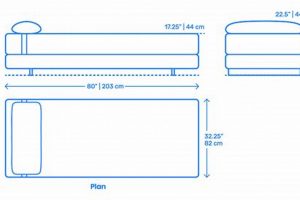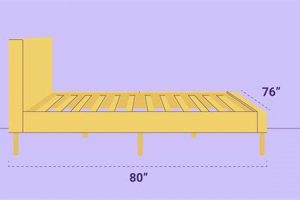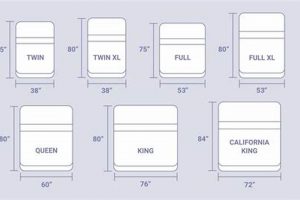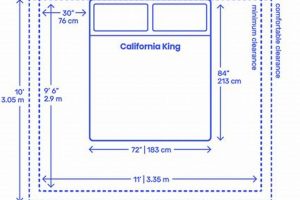The measurements of a support structure designed for a king-size sleeping surface are critical for ensuring proper fit and functionality. These measurements typically accommodate a mattress approximately 76 inches wide and 80 inches long, though slight variations may exist depending on the style of construction or design. Incorrect dimensions can lead to an unstable sleep surface, premature wear on the mattress, or aesthetic issues within the bedroom. For example, if the frame is too small, the mattress may overhang, creating a potential tripping hazard.
Proper sizing is important because it provides adequate support and enhances the longevity of the mattress. A well-fitted frame prevents sagging, which can compromise comfort and contribute to back pain. Historically, the need for standardized sizes emerged with the mass production of mattresses, allowing consumers to easily select a suitable frame. The benefits of adhering to these sizes include ease of assembly, enhanced sleep quality, and protection of the investment in a premium sleep product.
Understanding the nuances of these measurements is the first step in choosing the right bedroom furnishings. This knowledge informs decisions about platform versus traditional styles, the impact of headboard and footboard attachments, and the options for under-bed storage, all while guaranteeing a secure and visually appealing bedroom arrangement.
Essential Considerations
When selecting a foundation to accommodate a king-size mattress, careful attention to dimensional accuracy is crucial. The following points provide essential guidance for ensuring a compatible and supportive sleep system.
Tip 1: Verify Internal Measurements. Prior to purchase, confirm the internal length and width of the intended frame. The industry standard for a king-size mattress is 76 inches by 80 inches. Discrepancies, even minor ones, can affect stability and comfort.
Tip 2: Account for Headboard and Footboard. If the frame incorporates a headboard or footboard, factor in any additional space these components may occupy. Precise measurements are necessary to avoid obstructing walkways or interfering with other bedroom furniture.
Tip 3: Consider Bedding Thickness. The combined height of the mattress and any toppers or bedding will influence the overall bed height. Assess whether the resulting height is appropriate for ease of access and personal preference.
Tip 4: Assess Weight Capacity. Ensure that the chosen frame is rated to support the combined weight of the mattress and occupants. Exceeding the weight capacity can lead to structural damage and compromise the integrity of the support system.
Tip 5: Examine Slat Spacing. For slatted frames, verify that the spacing between individual slats is sufficient to prevent mattress sagging. Closer spacing provides more uniform support and extends the lifespan of the mattress.
Tip 6: Evaluate Material Durability. The construction material of the foundation contributes significantly to its longevity. Opt for frames constructed from robust materials such as solid wood or reinforced steel to ensure lasting stability.
Adhering to these considerations ensures the selection of a foundation that properly supports the mattress, enhances sleep quality, and provides long-term value. Accurate measurements are key to preventing potential issues and maximizing the lifespan of the investment.
The subsequent sections will delve into specific frame types and construction methodologies, offering further insights into selecting the ideal foundation for your needs.
1. Overall width
The overall width is a fundamental dimension defining a mattress support system’s capacity to securely house a standard king-size mattress. It represents the frame’s measurement from one side to the other, influencing not only the mattress fit but also the space the bed occupies within a room. Inadequate overall width causes mattress overhang, potentially leading to premature wear, instability, and a compromised aesthetic. Conversely, excessive width creates unsightly gaps and undermines the intended design.
For example, a support structure with an internal width of 75 inches, intended for a standard 76-inch wide king mattress, would result in one inch of the mattress extending beyond the frame on either side. This overhang diminishes edge support, accelerating wear on the mattress’s vulnerable perimeter. Furthermore, accurate overall width is essential for calculating room layout. The dimension affects decisions regarding bedside table placement, walk-around space, and the overall sense of balance and proportion within the bedroom environment. Manufacturers often provide both internal (mattress-supporting) and external (total frame) dimensions, necessitating careful consideration of both values during the selection process.
In summary, the overall width is not merely a single measurement but a crucial determinant of functionality, mattress lifespan, and spatial harmony within a bedroom. Understanding and accurately assessing this dimension is paramount when selecting a frame, ensuring both a secure fit for the mattress and a visually appealing, practical arrangement of the sleeping space. Disregard for this dimension leads to a cascade of negative consequences, from compromised comfort to diminished aesthetic appeal.
2. Overall Length
The overall length, a key aspect of king mattress frame dimensions, directly influences the comfort, functionality, and spatial considerations of a sleep setup. Precise measurements ensure proper mattress support and integration within the bedroom environment.
- Mattress Accommodation
The primary role of the overall length is to accommodate a standard king-size mattress, typically 80 inches long. A frame that is too short will cause the mattress to compress, leading to discomfort and potential damage. Conversely, a frame that is excessively long creates unsightly gaps, undermining the intended aesthetic and potentially posing a safety hazard. For example, if the frame is 78 inches in length, the mattress will be compressed and may cause a discomfort.
- Bedroom Space Planning
The overall length dictates the footprint of the bed within the room. This measurement is critical for effective space planning, ensuring sufficient clearance for walkways and other furniture. Inadequate consideration of the overall length results in cramped conditions, restricting movement and detracting from the room’s functionality. This is a main step for organizing the bedroom
- Headboard and Footboard Integration
The addition of a headboard or footboard increases the overall length. Manufacturers typically account for these additions in their specifications, but it is imperative to verify the complete length to avoid unexpected spatial constraints. A decorative headboard might add several inches, impacting the bed’s placement against a wall or within a specific area.
- Weight Distribution and Support
The length of a king mattress frame needs to provide support along the entire 80-inch length of the mattress. Proper weight distribution is crucial for maintaining the mattress’s integrity and preventing sagging or uneven wear. Insufficient support along the edges, particularly the foot, can shorten the mattress’s lifespan.
The facets of overall length, ranging from accommodating mattress dimensions to influencing bedroom space, highlight its centrality in ensuring a well-designed sleep environment. Failing to account for these elements results in discomfort, spatial inefficiencies, and compromised aesthetic. Understanding the interplay between these facets is vital for selecting a frame that harmonizes function and form.
3. Frame height
The frame height is a critical component when evaluating king mattress frame dimensions. It dictates the overall elevation of the sleeping surface above the floor, influencing ease of access, aesthetic integration with the room, and storage possibilities beneath the bed. An improperly chosen frame height can lead to difficulties getting in and out of bed, an unbalanced visual proportion within the bedroom, and either insufficient or inaccessible under-bed storage space. For example, a frame that is too low may be difficult for individuals with mobility issues, while one that is too high might create an awkward or cumbersome appearance.
Variations in frame height impact the perception of space and the functionality of the bedroom. Taller frames can create a sense of openness and provide ample storage space, whereas lower frames tend to convey a more minimalist or grounded aesthetic. The choice also affects cleaning accessibility; higher frames permit easier vacuuming underneath the bed, reducing dust accumulation. Furthermore, frame height interacts with the mattress thickness to determine the final sleep surface height. A thicker mattress on a lower frame may result in the same overall height as a thinner mattress on a taller frame, highlighting the importance of considering both factors when assessing suitability.
Selecting the appropriate frame height requires careful consideration of individual needs and preferences. Factors such as mobility limitations, desired storage capacity, and aesthetic preferences should all inform the decision. The frame height is not an isolated dimension but rather an integral part of the overall king mattress frame dimensions, impacting comfort, functionality, and the visual harmony of the bedroom.
4. Slat Spacing
Slat spacing, an integral element within the broader context of king mattress frame dimensions, exerts significant influence over mattress support, longevity, and overall sleep quality. The distance between individual slats directly correlates with the degree of support provided to the mattress. Excessive spacing leads to uneven weight distribution, potentially causing mattress sagging, particularly in areas subject to concentrated pressure. This can compromise spinal alignment and diminish sleep comfort. Conversely, insufficient spacing, while providing enhanced support, may restrict airflow, potentially impacting temperature regulation within the mattress. For instance, a king-size support structure with slats spaced 5 inches apart offers markedly different support characteristics compared to one with 2-inch spacing. The former increases the risk of sagging and premature wear, while the latter promotes more uniform support and potentially extends mattress life.
The material composition of the slats themselves also plays a crucial role. Solid wood slats, typically constructed from hardwoods like oak or maple, offer greater durability and load-bearing capacity than those made from softer woods or composite materials. Furthermore, the orientation of the slats whether they run lengthwise or crosswise affects their ability to withstand weight and resist bending. Lengthwise slats, spanning the width of the frame, are generally considered more resilient. Accurate slat spacing necessitates precise measurements within the king mattress frame dimensions. A frame intended for slats spaced 3 inches apart must adhere to this specification to ensure consistent support across the entire mattress surface. Deviations from this specification can undermine the frame’s structural integrity and reduce its effectiveness.
In summary, slat spacing within king mattress frame dimensions is a critical factor affecting mattress support and longevity. The distance between slats directly impacts weight distribution, spinal alignment, and overall sleep comfort. Selecting a frame with appropriate slat spacing, combined with durable slat materials, is essential for maximizing the lifespan of the mattress and ensuring a restful sleep experience. Neglecting this aspect can result in premature mattress wear, compromised sleep quality, and a diminished return on investment in both the mattress and the frame itself.
5. Headboard allowance
Headboard allowance is a critical, yet often overlooked, dimensional consideration when evaluating king mattress frame dimensions. This allowance refers to the space or compatibility features incorporated into a frame’s design to accommodate the attachment of a headboard. It directly influences aesthetic integration, structural stability, and overall compatibility of the bed setup.
- Mounting Mechanisms and Compatibility
Frames exhibit diverse mechanisms for headboard attachment, ranging from pre-drilled bolt holes to universal brackets. The headboard allowance ensures compatibility between the frame’s mounting system and the headboard’s attachment points. Incompatible systems necessitate modifications or workarounds, potentially compromising structural integrity. An example is a frame with pre-drilled holes that do not align with the headboard’s mounting points, rendering a secure connection impossible without drilling new holes.
- Dimensional Offset and Visual Harmony
The allowance considers the offset or distance between the frame’s edge and the headboard’s surface. This dimensional aspect is essential for achieving visual harmony and preventing the headboard from appearing awkwardly positioned relative to the mattress. Insufficient offset can make the headboard seem recessed or crowded, while excessive offset may create an unappealing gap. For instance, a minimalist headboard benefits from a minimal offset to maintain a sleek, integrated appearance.
- Structural Load and Support Distribution
A well-designed headboard allowance distributes the headboard’s weight evenly across the frame, preventing undue stress on specific points. This is particularly crucial for heavier headboards constructed from solid wood or upholstered materials. Insufficient allowance can lead to frame warping or damage over time. A robust frame with reinforced mounting points is essential to support the weight of a substantial headboard, ensuring long-term stability.
- Adjustability and Future Adaptability
Some frames incorporate adjustable headboard allowances, offering flexibility to accommodate headboards of varying thicknesses or designs. This feature enhances the frame’s adaptability, allowing for future headboard upgrades without requiring a complete frame replacement. A frame with adjustable brackets provides the option to switch between a thin, modern headboard and a thicker, more traditional design, extending the frame’s lifespan and utility.
The interplay between these facets underscores the importance of headboard allowance in achieving a functional and aesthetically pleasing king-size bed setup. Accurate assessment of this allowance, in conjunction with other key dimensions, ensures seamless integration, structural integrity, and long-term satisfaction. Neglecting this aspect can result in compatibility issues, visual imbalances, and compromised structural stability, ultimately detracting from the overall quality and longevity of the sleep environment.
Frequently Asked Questions
The following addresses common inquiries regarding the dimensions of support structures designed for king-size mattresses. These answers are intended to provide clarity and assist in making informed purchasing decisions.
Question 1: What are the standard interior dimensions of a frame designed for a king-size mattress?
The standard interior dimensions are 76 inches in width and 80 inches in length. These measurements ensure proper fit for a standard king mattress. Minor variations may exist depending on the style or design of the frame, but these measurements serve as the general guideline.
Question 2: How does frame height affect comfort and accessibility?
Frame height influences the overall bed height, affecting ease of getting in and out of bed. Lower frames may be more suitable for individuals who prefer a lower profile, while higher frames provide more under-bed storage and may be easier for those with mobility issues.
Question 3: What is the significance of slat spacing in a king-size bed frame?
Slat spacing affects the level of support provided to the mattress. Closer spacing provides more uniform support, preventing mattress sagging and extending its lifespan. Wider spacing can compromise support and lead to premature wear.
Question 4: How does the overall width of a frame impact room layout?
The overall width of a king frame determines the space it occupies within a room. Accurate measurements are crucial for planning the layout and ensuring sufficient clearance for walkways and other furniture.
Question 5: What is headboard allowance, and why is it important?
Headboard allowance refers to the compatibility features built into a frame to accommodate a headboard. It ensures proper attachment and aesthetic integration, preventing instability or visual imbalances.
Question 6: Does the frame material impact the dimensions or performance of a king-size support structure?
Yes, the frame material influences durability and weight capacity. Solid wood or reinforced steel frames provide greater stability and longevity than those made from weaker materials. This affects the dimensional stability over time.
Accurate dimensions are crucial for a comfortable and supportive sleep environment. These considerations help maximize mattress lifespan and ensure optimal use of space.
The subsequent section explores specific types of support systems, detailing their unique characteristics and dimensional considerations.
Conclusion
Understanding the specific measurements of a king mattress frame is not merely a matter of convenience, but a necessity for ensuring optimal mattress support, longevity, and bedroom functionality. Throughout this exploration, the importance of precise dimensions, including overall width, overall length, frame height, slat spacing, and headboard allowance, has been underscored. These factors directly influence the comfort, stability, and aesthetic integration of the sleep environment.
The implications of inaccurate “king mattress frame dimensions” extend beyond mere inconvenience, potentially leading to compromised sleep quality, premature mattress wear, and spatial inefficiencies. Therefore, careful consideration of these dimensional aspects is paramount when selecting a support structure. The long-term benefits of informed decision-making, including enhanced sleep and extended product lifespan, significantly outweigh the initial effort required to ensure dimensional accuracy. Continue to prioritize precise measurements in future purchasing decisions to maximize the value and utility of the sleep system.





![King vs California King: Mattress Dimensions Guide [2024] Organic & Natural Mattress Buyer’s Guide: Non-Toxic Sleep Solutions King vs California King: Mattress Dimensions Guide [2024] | Organic & Natural Mattress Buyer’s Guide: Non-Toxic Sleep Solutions](https://mattressworldpa.com/wp-content/uploads/2025/07/th-644-300x200.jpg)

![UK Mattress Dimensions Guide: Size & Fit [2024] Organic & Natural Mattress Buyer’s Guide: Non-Toxic Sleep Solutions UK Mattress Dimensions Guide: Size & Fit [2024] | Organic & Natural Mattress Buyer’s Guide: Non-Toxic Sleep Solutions](https://mattressworldpa.com/wp-content/uploads/2025/07/th-642-300x200.jpg)